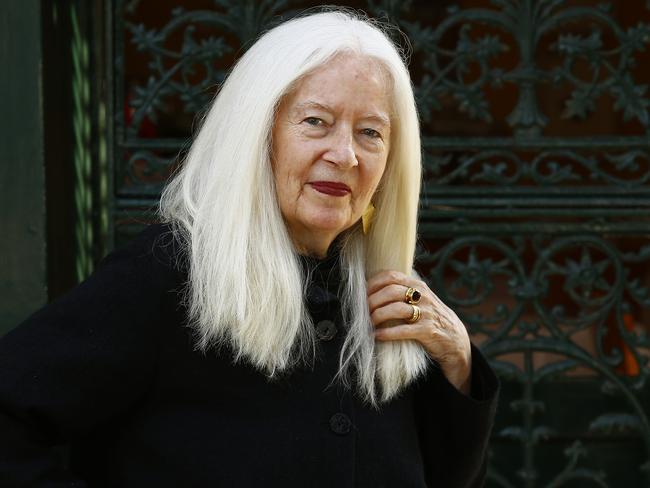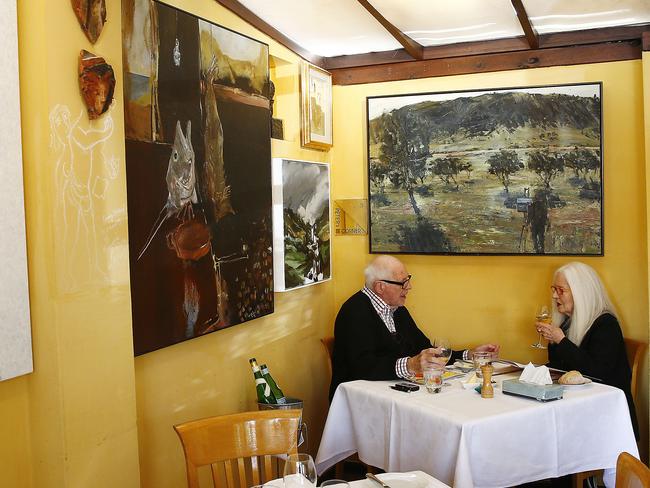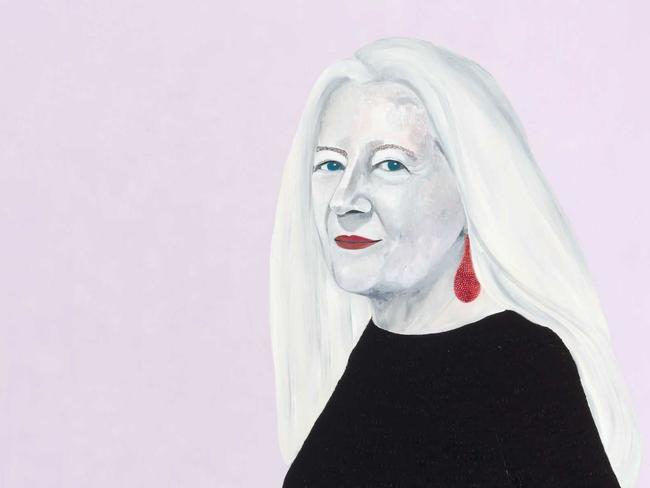A long table, draped in black, is set on the diagonal, spanning the spacious gallery pretty much corner to corner. Along the length of the table are small flat vases of mixed scarlet flowers, the handwork of Sydney’s star florist, Saskia Havekes.
On the stark white walls hang the latest works by Bill Henson, one of Australia’s most admired artists, dark brooding images of the twin churches of Santa Maria in Montesanto and Santa Maria dei Miracoliin Piazza del Popolo in Rome, of Palladio’s ravishing San Giorgio, seeming to float at midnight on the shimmering water of the Venetian lagoon, of unidentified classical ruins, of clouds and cliffs.
These are interspersed with neo-Caravaggist portraits of people including a haunting take on one of Renaissance art’s favourite images, the deposition of Christ from the cross.
Dinner tonight is for patrons and collectors but it also celebrates the return of Henson to Roslyn Oxley’s famous Paddington gallery.

It is more than five years since Henson showed here. It is also the scene of an unhappy moment in the artist’s career.
On May 22, 2008, the police received complaints that some of the works were obscene.
The complainants had not seen the works but had apparently received an email invitation to a private view that featured an image of a naked 13-year-old girl.
All hell broke loose. Feeding off a piece in the morning papers by a conservative columnist, shock jocks went into overdrive.
Talk back radio ran the story all day, PC Plod arrived, seized a number of pictures and the exhibition was cancelled.
As if he had nothing better to do, the Prime Minister of the day, Kevin Rudd, joined the fray, declaring the images to have “no artistic merit.” There followed the usual debate about artistic freedom, even threats of legal action and criminal charges against the artist for exhibiting pornographic material but the story eventually fizzled out.
A former director of the National Gallery of Australia Betty Churcher had the last word, summing up the whole sorry business: “The court,” she said, “is not the place to decide matters of art.”

Severely shaken by the whole affair, Henson retreated to his Melbourne fastness and it took years to coax him back to Sydney. His home town, Bleak City, with its cheek by jowl galleries in Flinders, Carlton and along Fitzroy Street, St. Kilda and some of the finest collections in the southern hemisphere is infinitely cooler and more cultivated than Sydney in matters artistic.
If Melbourne had wanted to get its knickers in a knot it would have done so back in the eighties when Ronnie di Stasio deployed a number of splendid Hensons on the walls of his superb eatery.
Oxley didn’t have a second thought about revisiting an artist who had previously stirred up such a controversy? “Not at all,” she tells me.
Oxley and husband and co-owner Tony have taken a calmer approach this time. All the publicity has been positive, there was a massive turn out for the opening.
Attendant festivities included two sold-out concerts in the gallery by the Australian Art Quartet and there has not been even a murmur from the philistines.
The Oxleys are happy.
A week later Ros Oxley and I are at lunch together. She is a familiar figure in Sydney, petite, softly spoken and seemingly shy with distinctive centre-parted shoulder-length white hair.
She has, one suspects, an iron will and a confidence born of old money. She is the daughter of Sir John and Lady Walton of the eponymous retail store. Tony’s parents were heirs to the Bushell’s tea fortune. They live in Carthona, an 1841 neo-Gothic house on a promontory in Darling Point.

Built for the colonial Surveyor General Sir Thomas Mitchell, it is one of the most romantic houses in Sydney. Educated at Ascham, Oxley proceeded in 1957 to art school, studying at what was then East Sydney Technical College, now the National Art School.
From which she graduated three years later, sailing into a job as interior designer with the leading architectural firm, Peddle Thorp and Walker. Founded in 1889, PTW as it is known, was the dominant architectural firm in the country in the boom decades after World War II and the senior partner Graham Thorp drove the firm to fabulous prosperity. A formidable powerbroker, he and his wife Jenny were prominent figures in eastern suburbs society. Oxley’s entry to the firm would have been a matter not only of talent but also of good connections.
“In 1961, PTW brought out Jon Andersen from Denmark to open a design section,” says Oxley as she rehearses the curve of her career.
“ I worked there for three or four years.”
A stint in Melbourne with Yuncken Freeman, that city’s leading architectural firm, was followed by further experience with Raymond Loewy in New York.
Millenialls may not be familiar with Loewy, the Franco-American who dominated the international design scene through the latter part of the twentieth century, dreaming up new shapes for cars, new designs for consumer goods from cigarette packets and razors to his most famous creation, the iconic Coca Cola bottle.
“Loewy was the biggest industrial design firm in the world,” she said.
In 1970 she married Tony Oxley. They travelled extensively, she for art, he for car racing.
“We were always at Le Mans or the Monaco Grand Prix.”
So why did these two young people decide to open a commercial art gallery?
“One day someone asked me ‘Why don’t you open a gallery? So we did.”
Oxley recalls the galley scene in those days before the boom in contemporary art and the proliferation of gallerists. It was a kind of dog eat dog atmosphere.
“Dealers were poaching artists from one another. And often leaving them high and dry when they couldn’t survive and their galleries closed. So I decided I’d have artists who were young and had never shown elsewhere. OK; this is where I’m going to go.”

As a mission statement it made sense. Roslyn Oxley Gallery emerged in 1982, a joint initiative of the Oxleys. Sydney was ready for it. Over the following thirty plus years she has become one of the most influential gallerists in Australia, a fearless supporter of contemporary art, ‘including that which is non-commercial and otherwise challenging’.
They have two daughters, Leyla and Omha. Leyla lives in the Southern Highlands,
Omha and her farmer husband live in the highlands too, the Highlands of Scotland, near Dingwall, north of Inverness. They are committed conservationists.
“They are into sustainability. Biomass, hydro, the lot. They even grow their own timber.
“We go to Scotland a lot. And they come out and spend time here.” The Oxleys travel a great deal, beyond Scotland, often to the major international art fairs.
Over the past thirty-three years, no fewer than eleven artists from the Oxley stable have shown in the Australian pavilion at the Venice Biennale, but she feels the venerable Venetian event has lost some of its sparkle.
“We like to visit the big German art fairs, Art Cologne and Documenta in Kassel.”
I tell her that a journalist friend of mine in Berlin sees art a ‘the key to unlocking Australia’ to the Germans. Oxley agrees.

I ask abut the commodification of contemporary art and cite specifically the astronomical price fetched recently at Christie’s in New York for one of Jeff Koons highs Rabbit sculptures.
Made of stainless steel and standing a metre high, it sold to hedge fund squillionaire for ninety one million American dollars (that’s over hundred and thirty two million Australian) to become the most expensive work by any modern artist ever sold at auction.
I suggest that this is not a unique work of art, there being two other examples plus an artist’s proof, this price borders on the absurd.
Oxley replies: ‘It’s worth it.”
I also ask if all artists get a swell dinner such as the one that heralded the Henson show.
“Not all. Sometimes we just take a few people home for a curry.”
For me, the return of Henson to Sydney stoked old memories.
It was 1996, the year of my last Melbourne Festival and if I say so myself it was a cracker.
Conductor Simone Young returned to Australia wreathed in laurels, an established star on the European classical music scene.
We agreed that I should go out and she should sail in on a wave of goodwill. The work we chose was Richard Strauss Die Frauohne Schtten a great lumbering but wonderful work which had never been seen in Australia.
It was a walloping success, not least of all because the set and costumes were designed by one of the most significant artists of the 20th century, First seen at London’s Covent Garden opera house and Los Angeles. David Hockney, who was suffering from advancing deafness, came to Melbourne to hear his beloved opera for the last time. He attended all the performances.

He also came down to a disused electrical sub station which Henson completely blacked out and on the sable walls placed fragments of his image — which he’d cut up so they resembled ancient frescoes revealed during an archaeological restoration.
It was a kind of coup de theatre.
Hockney, was knocked out as were the hundreds of visitors to this magical installation.
I had a similar feeling about Henson’s latest show.
Go see it. Mad it you don’t. And surrender to the ineffable beauty of the images, any one of which I’d covet more than the Koons rabbit.
Although the thought of offloading that shiny bunny for a hundred million smackeroos is tempting.

Add your comment to this story
To join the conversation, please log in. Don't have an account? Register
Join the conversation, you are commenting as Logout
Here’s what you can expect with tomorrow’s Parramatta weather
As spring sets in what can locals expect tomorrow? We have the latest word from the Weather Bureau.
FBI warning as Israel reveals how it will mark October 7
A chilling message has been issued as Israel prepares to mark the grim anniversary of the attack that changed the world. See the photos, video.